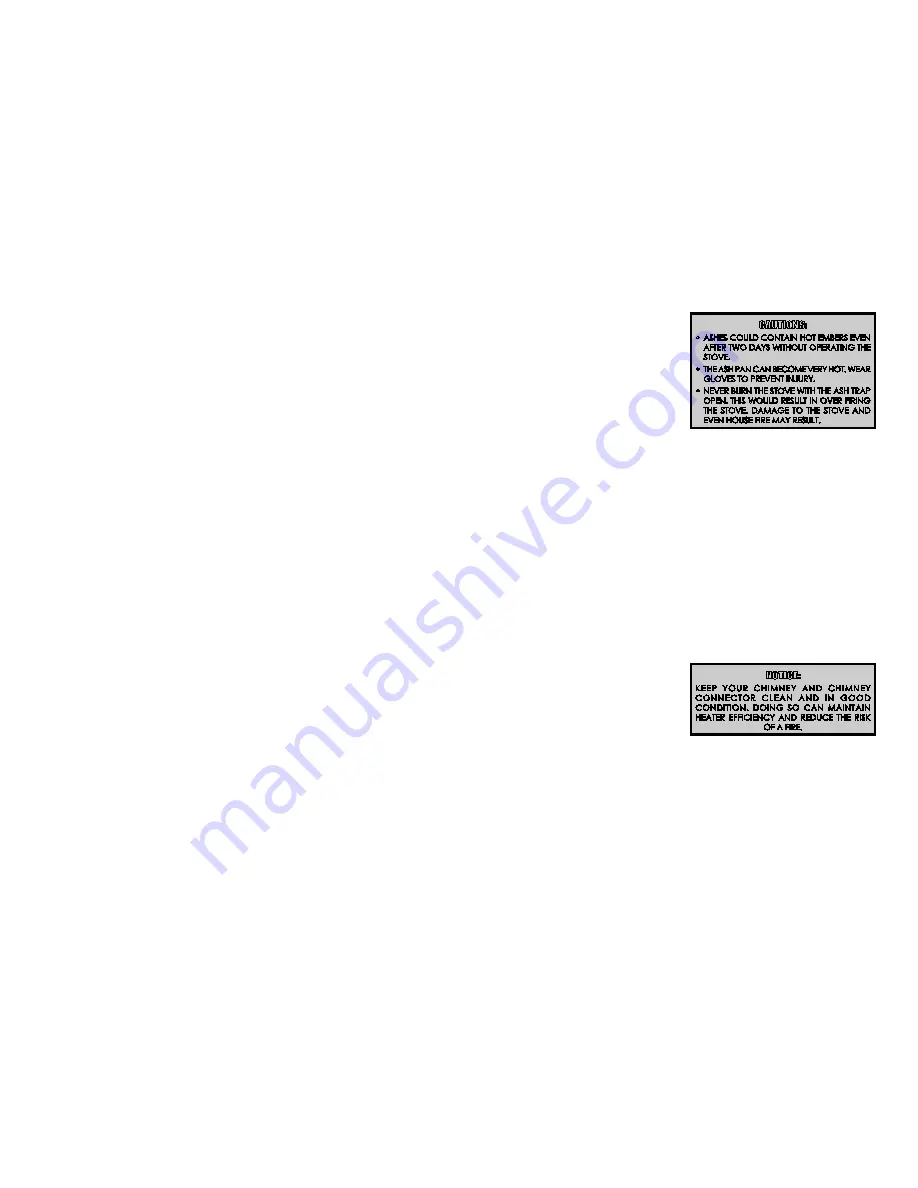
vENTINg INTO A FIREpLACE
Many people may wish to convert an existing
fireplace to heater use. Usually, safe con-
nection of stovepipe to a masonry chimney
requires more effort than connection to a
prefabricated chimney. The fireplace must
be closed and sealed at the damper in the
flue. Good sealants are high temperature
caulking, ceramic wool, and furnace ce-
ment. Always remember to inspect the
masonry chimney and fireplace. If neces-
sary, clean the flue and smoke shelf before
beginning your installation. Install the heater
into the chimney so that the system can be
dismantled for cleaning and inspection.
Before deciding to convert your fireplace
or existing chimney, keep in mind that older
fireplaces and their chimneys are unsafe.
They must be structurally sound, and the
flue liner must be in good condition.
Do
not use a chimney if it is unlined (should
have a tile clay liner to protect brickwork),
have it relined professionally.
Clearances to
combustibles are explained in the previous
section on masonry chimneys. If you have
any questions regarding the condition of
the chimney, consult a qualified engineer,
competent mason, certified Chimney Sweep,
or knowledgeable inspector.
Many prefabricated fireplaces fall into the
“zero-clearance fireplace” category. This is
a factory metal fireplace with multi-layered
construction. It is designed to provide enough
insulation and/or air cooling so that the base,
back and sides can be safely placed in close
contact with combustible floors and walls.
Although many prefabricated fireplaces
have been tested by nationally recognized
organizations for use as fireplaces, they have
not been tested to accept heaters. In fact,
their use as such may void the manufacturer’s
warranty.
Steel-lined fireplaces, on the other hand,
can be used with heaters. These units use a
1/4-inch fire box liner and an air chamber in
connection with 8 inches of masonry to meet
code. They contain all the essential parts of
a fireplace, firebox, damper, throat, smoke
shelf, and smoke chamber. Many of them
look exactly like a masonry fireplace and must
be checked closely for above requirements
before installing a coal heater into them.
Another method frequently used by some
people is to vent the heater directly into the
fireplace. This does not meet code since the
heater is being vented into another appli-
ance - the fireplace. This method should not
be attempted because combustion products
will deposit and build up in the firebox or
fireplace. Be certain not to install a hazard in
you house.
You will void your warranty with
this installation.
Connection of the stovepipe directly into the
existing masonry chimney over the fireplace
opening is the only approved method. This
installation performs better, yielding easy to
clean and inspect for creosote. Before begin-
ning this type of installation plan carefully; a
high degree of skill is required to insure safety.
An entry port for the stovepipe must be cut
through the chimney with minimum damage
to the fire clay liner. Some involved measure-
ments may be required to locate the flue liner
exactly. Before cutting, take time to mark the
size and position of the entry port. Position the
entry port so that at least 8 inches of the flue
liner remains below the port.
Keep in mind that wood mantels and com-
bustible trim around the fireplace must have
adequate clearances from the heater and
stovepipe or must be protected in an ap-
proved manner. Also, be sure to leave at
least 24” clearance between the top of the
stovepipe and the combustible ceiling or
other combustibles. Placing the center of the
entry port 2 feet below the ceiling will insure
proper clearance for 6 inch, 8 inch, and 10
inch stovepipes. Next, install a fire clay (at least
5/8 in. thick) or metal thimble, being sure that
the thimble is flush with the inner flue lining.
Secure the thimble in place with refractory
mortar. The thimble should be surrounded
on all sides with 8 inches of brickwork (solid
masonry units) or 24 inches of stone.
Install the stovepipe as far as possible into
the thimble, but not past the inside of the
flue lining. There should be a small air space
(approximately 1/2 in.) between the stove-
pipe and thimble, allowing for expansion
of the stovepipe. Seal this airspace with
high-temperature caulking or ceramic wool.
Finally, be sure to wire the damper closed
and apply the same sealant you used at the
stovepipe and thimble junction.
Do not vent up through the fireplace opening,
regardless of whether the fireplace opening
is closed.
MAINTENANCE
DISPOSAL of ASHES
Ashes should be removed from the stove every
few days or when ashes get to 2 to 3 inches
deep. Always empty the stove when it is cold,
such as in the morning. Ashes should be placed
in a metal container with a tight fitting lid. The
closed container of ashes should be placed on
a non combustible floor or on the ground, well
away from all combustible materials, pending
final disposal. If the ashes are disposed of by
burial in soil or otherwise locally dispersed, they
should be retained in the close container until all
cinders have thoroughly cooled. Do not use the
ash container to dispose of other trash.
CAUTIONS:
• ASHES COULD CONTAIN HOT EMBERS EVEN
AFTER TWO DAYS WITHOUT OPERATING THE
STOVE.
• THE ASH PAN CAN BECOME VERY HOT. WEAR
GLOVES TO PREVENT INJURY.
• NEVER BURN THE STOVE WITH THE ASH TRAP
OPEN. THIS WOULD RESULT IN OVER FIRING
THE STOVE. DAMAGE TO THE STOVE AND
EVEN HOUSE FIRE MAY RESULT.
CREOSOTE / SOOT - FORMATION AND NEED FOR REMOVAL
When wood or coal is burned slowly, it produces
tar and other organic vapors, which combine
with expelled moisture to form creosote or soot.
The creosote vapors condense in the relatively
cool chimney flue of a slow-burning fire. As a
result, creosote/soot residue accumulates on
the flue lining. When ignited this creosote/soot
makes an extremely hot fire. When burning wood
or coal, the chimney connector and chimney
should be inspected at least twice a month during
the heating season to determine if a creosote/
soot build-up has occurred. If creosote/soot has
accumulated, it should be removed to reduce the
risk of a chimney fire.
If a chimney or creosote fire occurs, close all
dampers immediately and call the fire department.
Once a chimney fire occurs, it can only be
extinguished by removing its source of oxygen. This
can be accomplished by shutting any mechanical
draft devices and/or discharging a CO² (Carbon
Dioxide) or Halon fire extinguisher directly into the
heater through an appropriately placed cleanout.
If using a Halon extinguisher, please note that it
totally displaces oxygen and could become a
hazard in itself if enough is discharged into the
living space.
Wait for the heater to cool, then inspect the
chimney area for damage. A chimney fire may
cause ignition of wall studs or rafters which you
thought were at a safe distance from the chimney.
If no damage results, perform a chimney cleaning
to ensure there is no more creosote deposits
remaining in the chimney. We suggest having your
chimney inspected by a qualified person before
using again.
Establish a routine technique for seasoning, storing,
and burning your fuel. Check daily for creosote
build-up until experience shows how often you
need to clean to be safe. Be aware that the hotter
the fire, the less creosote or soot is deposited and
weekly cleaning may be necessary in mild weather
even though monthly cleaning may be enough
during the colder months. Contact your local
municipal or provincial fire authority for information
on how to handle a chimney fire if one occurs.
Have a clearly understood plan to handle the
situation if such an event were to happen.
8
17
NOTICE:
KEEP YOUR CHIMNEY AND CHIMNEY
CONNECTOR CLEAN AND IN GOOD
CONDITION. DOING SO CAN MAINTAIN
HEATER EFFICIENCY AND REDUCE THE RISK
OF A FIRE.






























